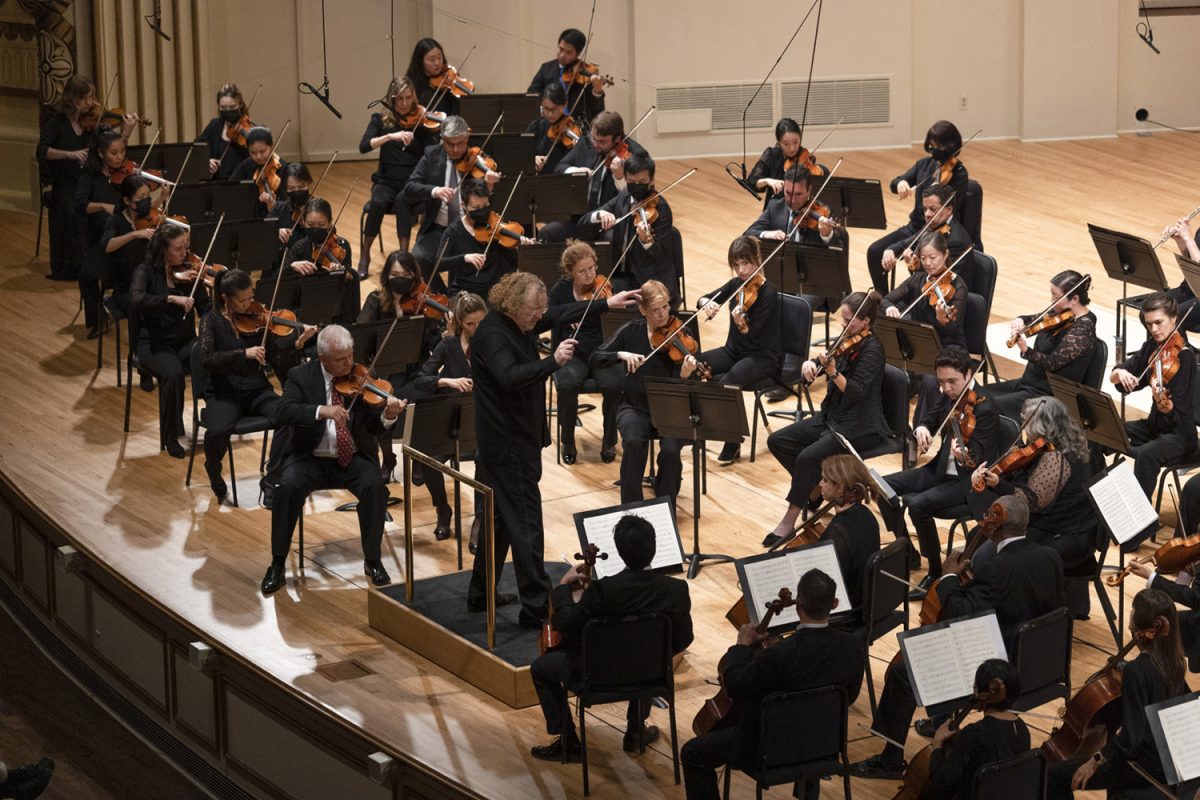As the last note was held, the auditorium became quieter and quieter. All that was left was your heart beating in your chest. You could hear a pin drop. Scissors would struggle to cut the tension. As the conductor lowered his hands, the audience rose to their feet in a standing ovation.
On Nov. 17, the St. Louis Symphony Orchestra took the stage at Hancher Auditorium in Iowa City. The event took place on Hadley Stage, a vast concert hall with high, looming ceilings hung with abstract light fixtures.
Under conductor Stéphane Denève, the St. Louis Symphony Orchestra presented an exploration of Wolfgang Amadeus Mozart’s music “from London to Vienna.” From his first symphonic work composed at age eight to his symphony brought about by the death of his mother, the performance covered it all.
“The thing that makes Mozart such an extraordinary composer is that even at eight years old, you hear so much of his mature sound in his writing,” Assistant Conductor Sam Hollister said regarding Symphony No. 1.
The members of the Symphony Orchestra could be seen swaying and moving their heads with the music, losing themselves in the beautiful harmonies of Mozart’s craftsmanship. This not only makes the music sound more thoughtful but conveys a meaningful message to the audience.
Mozart, even at such a young age, was infatuated with the use of suspensions, or when a note from a chord is carried over to the next. However, the initial note does not fit with the following chord, creating an almost uncomfortable feeling for the listener, which is then resolved when the note takes a step up or down. This technique is used frequently throughout many of Mozart’s early works.
“There’s so much narrative in the interplay, I think, between the orchestra and the soloist at the very beginning of the first movement that sets up the kind of connotations of the entire concerto,” Hollister said about the “Piano Concerto No. 20.”
The piece started with a very ominous melody in the upper strings, with the lower strings backing it with a simpler melody, creating a polyphonic atmosphere. The piano entered with a very melancholic expression. The pianist, Behzod Abduraimov, started with light and precise fingers.
RELATED: Iowa City Poetry hosts Mic Check Poetry Festival
Abduraimov, an incredibly talented pianist from Tashkent, Uzbekistan, swayed back and forth as he graced across the keys. Performing with so much emotion, it was hard not to get caught up in it from the audience — Abduraimov playing slow and thoughtfully one moment, and then playing with such speed and elegance you’d think the piano could go up in flames. As the piece concluded, he received a standing ovation that lasted several minutes.
As the penultimate piece was being set to play, all the chairs were removed, and 15 stands were left surrounding the conductor’s podium.
“When you have a whole section of violinists playing the same thing, their sound blends together in a sort of watercolor style,” Hollister said about “Within Her Arms,” by Anna Clyne. “But when you have one person playing a solo part, you hear every nuance of their vibrato, their bow, and the speed of their expression.”
This piece by Clyne consists of 15 different parts. In this case, each of these parts was filled by one person. This created a more intimate piece of music.
The piece started off with a couple of violinists playing a delicate melody. Throughout the piece, more and more instruments were added: violas, cellos, and double bass. Each member played a fleeting melody. Even if a single person played for only a few beats, they acted as if it was the last thing they’d ever play.
At the end of the piece, the conductor left the audience in suspense as he let them sit in silence for what felt like an eternity. Eventually, Denève’s arms fell, signaling the end of the piece, which allowed the crowd to erupt in a burst of cheers.



